An Examination of Policy, Power, and Politics in Healthcare Provision
VerifiedAdded on 2023/06/13
|10
|2285
|165
Essay
AI Summary
This essay provides a comprehensive analysis of the interplay between policy, power, and politics in healthcare provision. It examines the Australian Policy Cycle, highlighting its eight steps and its significance in policymaking. The essay also differentiates between health policy, government policy documents, and evidence-based policy, discussing their roles and implications. It further explores the evolving definitions of health and the shift towards a more holistic, population-based approach in public health, contrasting it with older models. The impact of sociological issues on health, including socioeconomic status and cultural factors, is also discussed. Finally, the essay addresses the challenges and benefits of interconnected systems in healthcare, particularly electronic health records, emphasizing the complexities of implementation and potential for improved care.
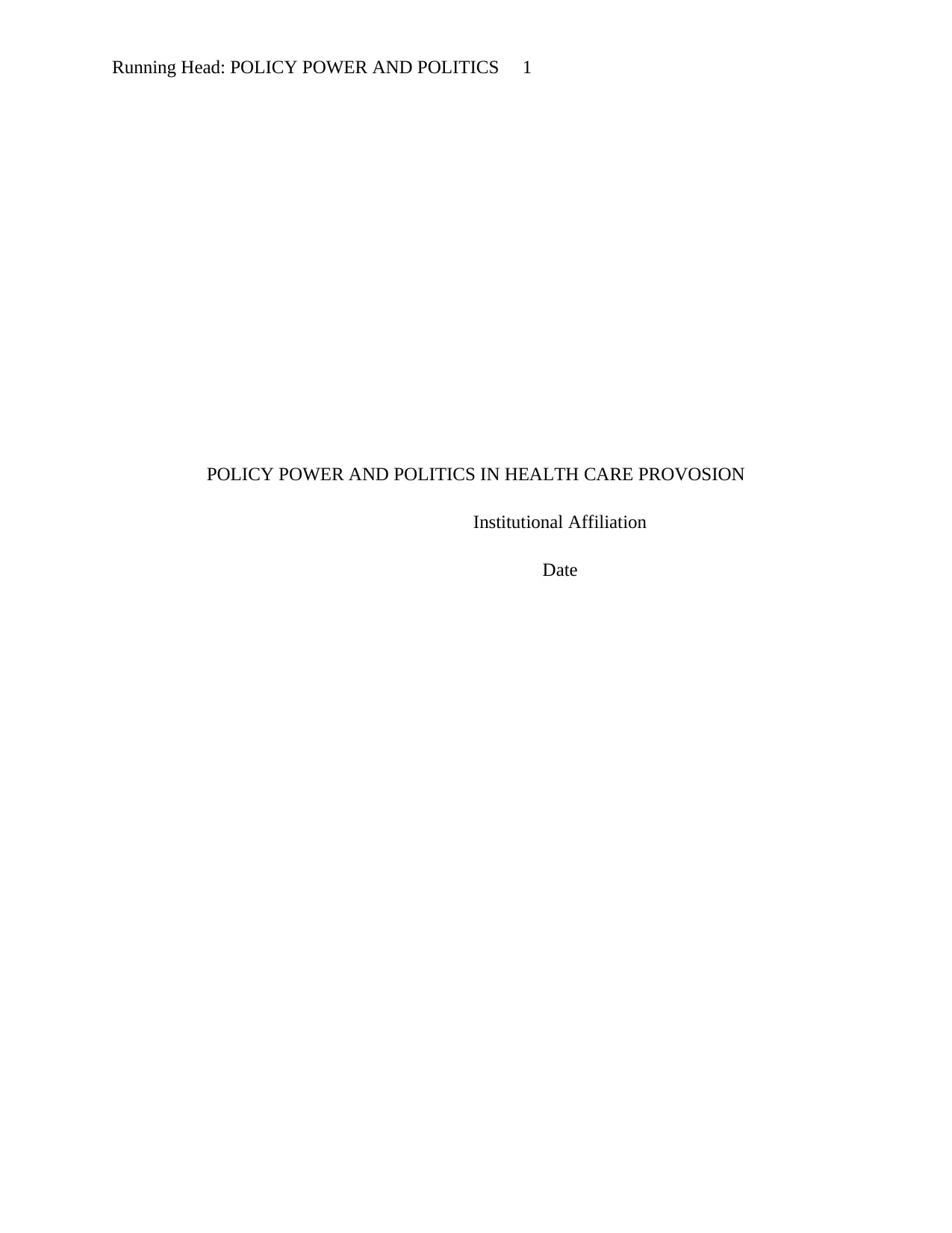
Running Head: POLICY POWER AND POLITICS 1
POLICY POWER AND POLITICS IN HEALTH CARE PROVOSION
Institutional Affiliation
Date
POLICY POWER AND POLITICS IN HEALTH CARE PROVOSION
Institutional Affiliation
Date
Paraphrase This Document
Need a fresh take? Get an instant paraphrase of this document with our AI Paraphraser

POLICY POWER AND POLITICS 2
Question one
The Australian Policy Cycle
Policymaking has a chain of identifiable steps. Davis and Bridgman have claimed to have
generated a policy cycle model that is both normative and descriptive. The theorists argue that
every fundamental element involving their policy cycle model should be incorporated to enable
systematic thinking reduce policy errors. The policy cycle also introduces a component of
intellectual consistency to analysis policy-making. Ideally, the model has attracted much
scrutiny, analysis, criticism as well as the debate because it was first to be created and carries on
to be a useful device within the kit of every public servant. The eight steps involved in the policy
cycle include; Issue identification, policy analysis, policy instrument development, consultation,
coordination, decision, implementation and finally evaluation (Freeman, 2013). These steps
follow each other as they are mentioned which in fact helps in encouraging an ongoing, cyclic
and an interactive approach towards developing and boosting policy as time goes on. As a result,
the process will eventually increase the inputs and the experience within the healthcare setting.
Reflecting on the eight steps of the cycle implies that the policy makers coordinate and
manage the whole process. This offers an indication of where the policies originate from, who is
involved, external pressures and issues as well as how policies work from an idea to being
implemented. A policy cycle is an appropriate tool in two significant ways. First, the model
presents an essential reference model for classifying many potential parts involving policy
development. Secondly, the model is educational for policy financiers to enable them to
understand the prospects and tactic embraced by their peers within the public service. For
instance, the cycle offers a basic outline that policymakers should use as they think of planning
Question one
The Australian Policy Cycle
Policymaking has a chain of identifiable steps. Davis and Bridgman have claimed to have
generated a policy cycle model that is both normative and descriptive. The theorists argue that
every fundamental element involving their policy cycle model should be incorporated to enable
systematic thinking reduce policy errors. The policy cycle also introduces a component of
intellectual consistency to analysis policy-making. Ideally, the model has attracted much
scrutiny, analysis, criticism as well as the debate because it was first to be created and carries on
to be a useful device within the kit of every public servant. The eight steps involved in the policy
cycle include; Issue identification, policy analysis, policy instrument development, consultation,
coordination, decision, implementation and finally evaluation (Freeman, 2013). These steps
follow each other as they are mentioned which in fact helps in encouraging an ongoing, cyclic
and an interactive approach towards developing and boosting policy as time goes on. As a result,
the process will eventually increase the inputs and the experience within the healthcare setting.
Reflecting on the eight steps of the cycle implies that the policy makers coordinate and
manage the whole process. This offers an indication of where the policies originate from, who is
involved, external pressures and issues as well as how policies work from an idea to being
implemented. A policy cycle is an appropriate tool in two significant ways. First, the model
presents an essential reference model for classifying many potential parts involving policy
development. Secondly, the model is educational for policy financiers to enable them to
understand the prospects and tactic embraced by their peers within the public service. For
instance, the cycle offers a basic outline that policymakers should use as they think of planning
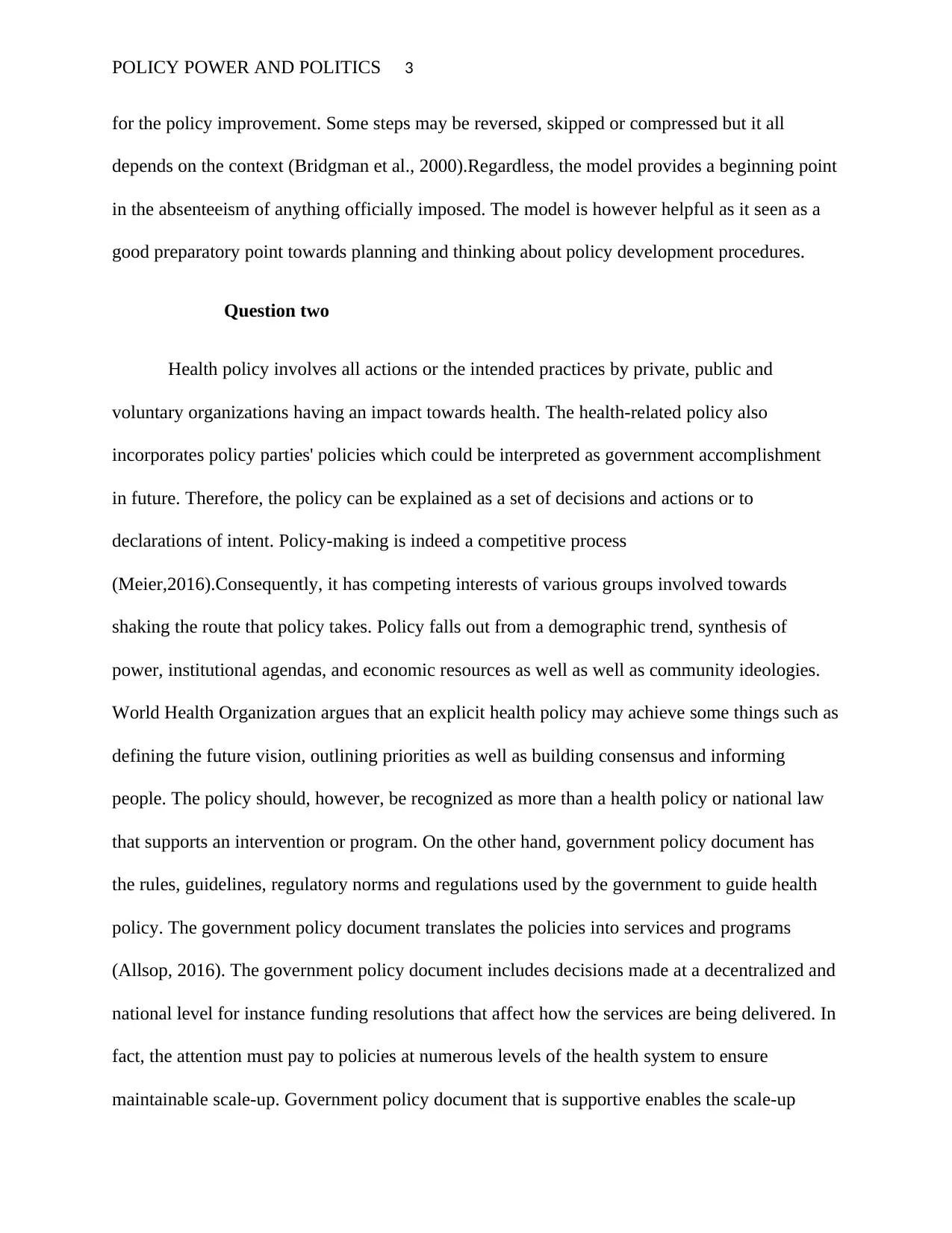
POLICY POWER AND POLITICS 3
for the policy improvement. Some steps may be reversed, skipped or compressed but it all
depends on the context (Bridgman et al., 2000).Regardless, the model provides a beginning point
in the absenteeism of anything officially imposed. The model is however helpful as it seen as a
good preparatory point towards planning and thinking about policy development procedures.
Question two
Health policy involves all actions or the intended practices by private, public and
voluntary organizations having an impact towards health. The health-related policy also
incorporates policy parties' policies which could be interpreted as government accomplishment
in future. Therefore, the policy can be explained as a set of decisions and actions or to
declarations of intent. Policy-making is indeed a competitive process
(Meier,2016).Consequently, it has competing interests of various groups involved towards
shaking the route that policy takes. Policy falls out from a demographic trend, synthesis of
power, institutional agendas, and economic resources as well as well as community ideologies.
World Health Organization argues that an explicit health policy may achieve some things such as
defining the future vision, outlining priorities as well as building consensus and informing
people. The policy should, however, be recognized as more than a health policy or national law
that supports an intervention or program. On the other hand, government policy document has
the rules, guidelines, regulatory norms and regulations used by the government to guide health
policy. The government policy document translates the policies into services and programs
(Allsop, 2016). The government policy document includes decisions made at a decentralized and
national level for instance funding resolutions that affect how the services are being delivered. In
fact, the attention must pay to policies at numerous levels of the health system to ensure
maintainable scale-up. Government policy document that is supportive enables the scale-up
for the policy improvement. Some steps may be reversed, skipped or compressed but it all
depends on the context (Bridgman et al., 2000).Regardless, the model provides a beginning point
in the absenteeism of anything officially imposed. The model is however helpful as it seen as a
good preparatory point towards planning and thinking about policy development procedures.
Question two
Health policy involves all actions or the intended practices by private, public and
voluntary organizations having an impact towards health. The health-related policy also
incorporates policy parties' policies which could be interpreted as government accomplishment
in future. Therefore, the policy can be explained as a set of decisions and actions or to
declarations of intent. Policy-making is indeed a competitive process
(Meier,2016).Consequently, it has competing interests of various groups involved towards
shaking the route that policy takes. Policy falls out from a demographic trend, synthesis of
power, institutional agendas, and economic resources as well as well as community ideologies.
World Health Organization argues that an explicit health policy may achieve some things such as
defining the future vision, outlining priorities as well as building consensus and informing
people. The policy should, however, be recognized as more than a health policy or national law
that supports an intervention or program. On the other hand, government policy document has
the rules, guidelines, regulatory norms and regulations used by the government to guide health
policy. The government policy document translates the policies into services and programs
(Allsop, 2016). The government policy document includes decisions made at a decentralized and
national level for instance funding resolutions that affect how the services are being delivered. In
fact, the attention must pay to policies at numerous levels of the health system to ensure
maintainable scale-up. Government policy document that is supportive enables the scale-up
⊘ This is a preview!⊘
Do you want full access?
Subscribe today to unlock all pages.

Trusted by 1+ million students worldwide
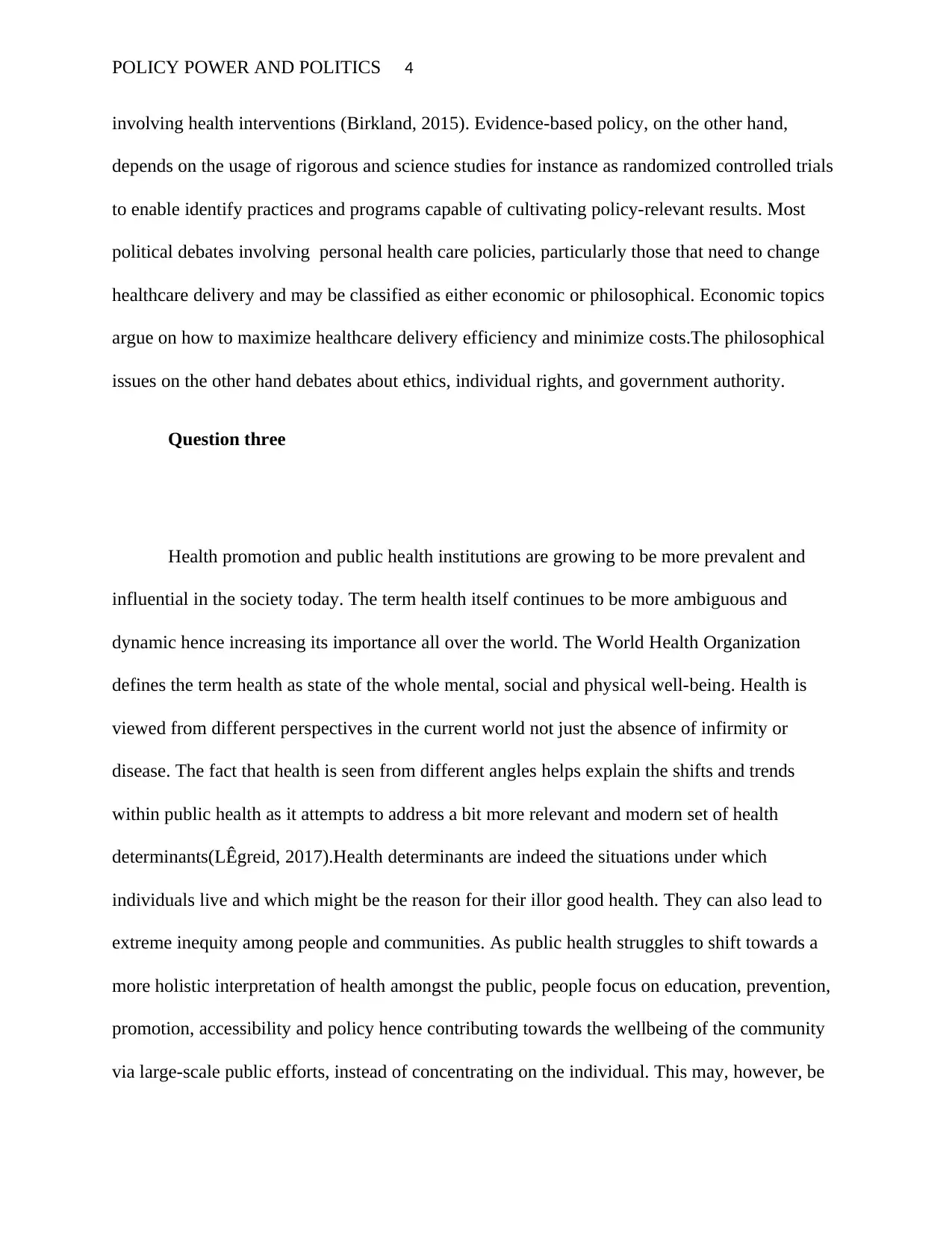
POLICY POWER AND POLITICS 4
involving health interventions (Birkland, 2015). Evidence-based policy, on the other hand,
depends on the usage of rigorous and science studies for instance as randomized controlled trials
to enable identify practices and programs capable of cultivating policy-relevant results. Most
political debates involving personal health care policies, particularly those that need to change
healthcare delivery and may be classified as either economic or philosophical. Economic topics
argue on how to maximize healthcare delivery efficiency and minimize costs.The philosophical
issues on the other hand debates about ethics, individual rights, and government authority.
Question three
Health promotion and public health institutions are growing to be more prevalent and
influential in the society today. The term health itself continues to be more ambiguous and
dynamic hence increasing its importance all over the world. The World Health Organization
defines the term health as state of the whole mental, social and physical well-being. Health is
viewed from different perspectives in the current world not just the absence of infirmity or
disease. The fact that health is seen from different angles helps explain the shifts and trends
within public health as it attempts to address a bit more relevant and modern set of health
determinants(LÊgreid, 2017).Health determinants are indeed the situations under which
individuals live and which might be the reason for their illor good health. They can also lead to
extreme inequity among people and communities. As public health struggles to shift towards a
more holistic interpretation of health amongst the public, people focus on education, prevention,
promotion, accessibility and policy hence contributing towards the wellbeing of the community
via large-scale public efforts, instead of concentrating on the individual. This may, however, be
involving health interventions (Birkland, 2015). Evidence-based policy, on the other hand,
depends on the usage of rigorous and science studies for instance as randomized controlled trials
to enable identify practices and programs capable of cultivating policy-relevant results. Most
political debates involving personal health care policies, particularly those that need to change
healthcare delivery and may be classified as either economic or philosophical. Economic topics
argue on how to maximize healthcare delivery efficiency and minimize costs.The philosophical
issues on the other hand debates about ethics, individual rights, and government authority.
Question three
Health promotion and public health institutions are growing to be more prevalent and
influential in the society today. The term health itself continues to be more ambiguous and
dynamic hence increasing its importance all over the world. The World Health Organization
defines the term health as state of the whole mental, social and physical well-being. Health is
viewed from different perspectives in the current world not just the absence of infirmity or
disease. The fact that health is seen from different angles helps explain the shifts and trends
within public health as it attempts to address a bit more relevant and modern set of health
determinants(LÊgreid, 2017).Health determinants are indeed the situations under which
individuals live and which might be the reason for their illor good health. They can also lead to
extreme inequity among people and communities. As public health struggles to shift towards a
more holistic interpretation of health amongst the public, people focus on education, prevention,
promotion, accessibility and policy hence contributing towards the wellbeing of the community
via large-scale public efforts, instead of concentrating on the individual. This may, however, be
Paraphrase This Document
Need a fresh take? Get an instant paraphrase of this document with our AI Paraphraser
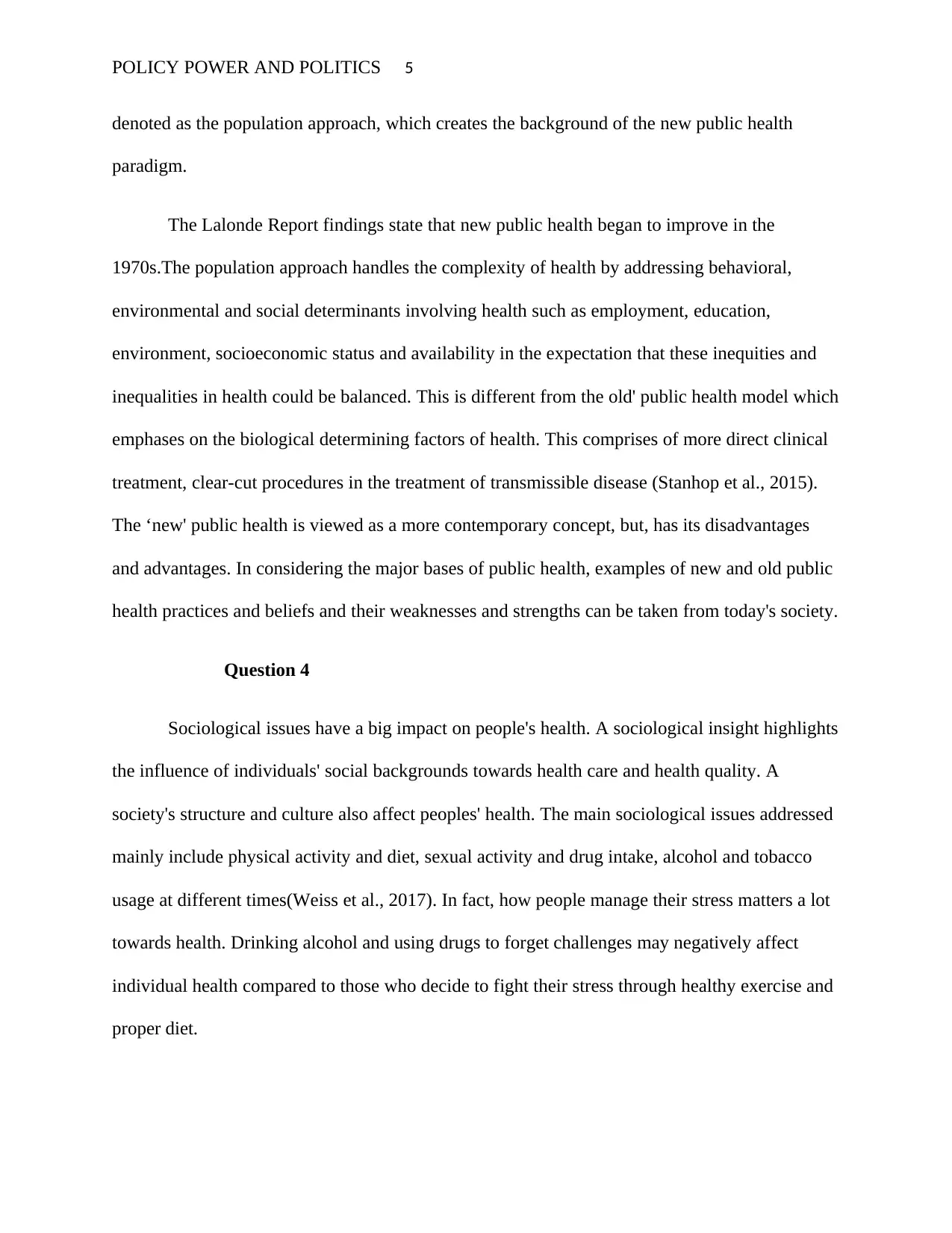
POLICY POWER AND POLITICS 5
denoted as the population approach, which creates the background of the new public health
paradigm.
The Lalonde Report findings state that new public health began to improve in the
1970s.The population approach handles the complexity of health by addressing behavioral,
environmental and social determinants involving health such as employment, education,
environment, socioeconomic status and availability in the expectation that these inequities and
inequalities in health could be balanced. This is different from the old' public health model which
emphases on the biological determining factors of health. This comprises of more direct clinical
treatment, clear-cut procedures in the treatment of transmissible disease (Stanhop et al., 2015).
The ‘new' public health is viewed as a more contemporary concept, but, has its disadvantages
and advantages. In considering the major bases of public health, examples of new and old public
health practices and beliefs and their weaknesses and strengths can be taken from today's society.
Question 4
Sociological issues have a big impact on people's health. A sociological insight highlights
the influence of individuals' social backgrounds towards health care and health quality. A
society's structure and culture also affect peoples' health. The main sociological issues addressed
mainly include physical activity and diet, sexual activity and drug intake, alcohol and tobacco
usage at different times(Weiss et al., 2017). In fact, how people manage their stress matters a lot
towards health. Drinking alcohol and using drugs to forget challenges may negatively affect
individual health compared to those who decide to fight their stress through healthy exercise and
proper diet.
denoted as the population approach, which creates the background of the new public health
paradigm.
The Lalonde Report findings state that new public health began to improve in the
1970s.The population approach handles the complexity of health by addressing behavioral,
environmental and social determinants involving health such as employment, education,
environment, socioeconomic status and availability in the expectation that these inequities and
inequalities in health could be balanced. This is different from the old' public health model which
emphases on the biological determining factors of health. This comprises of more direct clinical
treatment, clear-cut procedures in the treatment of transmissible disease (Stanhop et al., 2015).
The ‘new' public health is viewed as a more contemporary concept, but, has its disadvantages
and advantages. In considering the major bases of public health, examples of new and old public
health practices and beliefs and their weaknesses and strengths can be taken from today's society.
Question 4
Sociological issues have a big impact on people's health. A sociological insight highlights
the influence of individuals' social backgrounds towards health care and health quality. A
society's structure and culture also affect peoples' health. The main sociological issues addressed
mainly include physical activity and diet, sexual activity and drug intake, alcohol and tobacco
usage at different times(Weiss et al., 2017). In fact, how people manage their stress matters a lot
towards health. Drinking alcohol and using drugs to forget challenges may negatively affect
individual health compared to those who decide to fight their stress through healthy exercise and
proper diet.
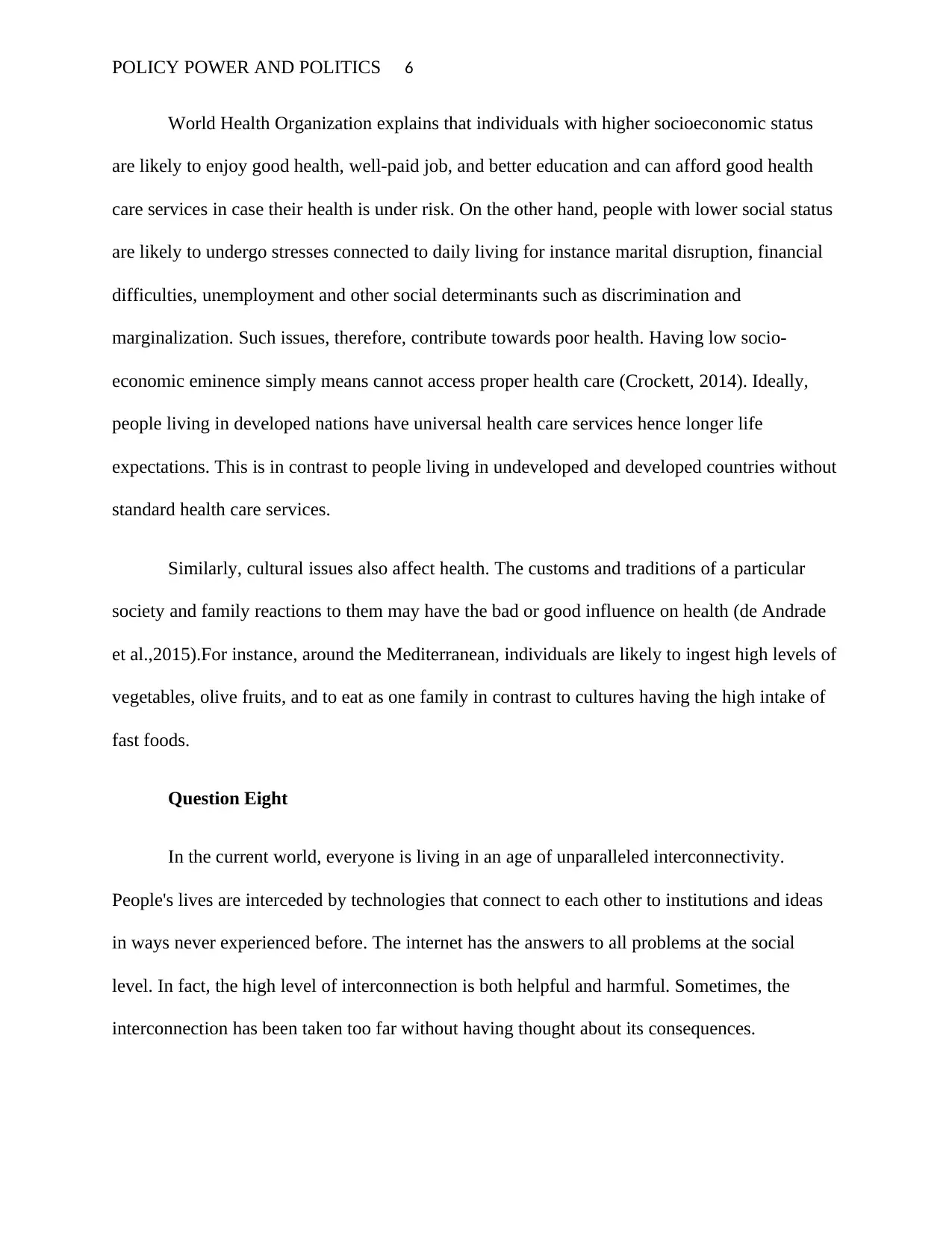
POLICY POWER AND POLITICS 6
World Health Organization explains that individuals with higher socioeconomic status
are likely to enjoy good health, well-paid job, and better education and can afford good health
care services in case their health is under risk. On the other hand, people with lower social status
are likely to undergo stresses connected to daily living for instance marital disruption, financial
difficulties, unemployment and other social determinants such as discrimination and
marginalization. Such issues, therefore, contribute towards poor health. Having low socio-
economic eminence simply means cannot access proper health care (Crockett, 2014). Ideally,
people living in developed nations have universal health care services hence longer life
expectations. This is in contrast to people living in undeveloped and developed countries without
standard health care services.
Similarly, cultural issues also affect health. The customs and traditions of a particular
society and family reactions to them may have the bad or good influence on health (de Andrade
et al.,2015).For instance, around the Mediterranean, individuals are likely to ingest high levels of
vegetables, olive fruits, and to eat as one family in contrast to cultures having the high intake of
fast foods.
Question Eight
In the current world, everyone is living in an age of unparalleled interconnectivity.
People's lives are interceded by technologies that connect to each other to institutions and ideas
in ways never experienced before. The internet has the answers to all problems at the social
level. In fact, the high level of interconnection is both helpful and harmful. Sometimes, the
interconnection has been taken too far without having thought about its consequences.
World Health Organization explains that individuals with higher socioeconomic status
are likely to enjoy good health, well-paid job, and better education and can afford good health
care services in case their health is under risk. On the other hand, people with lower social status
are likely to undergo stresses connected to daily living for instance marital disruption, financial
difficulties, unemployment and other social determinants such as discrimination and
marginalization. Such issues, therefore, contribute towards poor health. Having low socio-
economic eminence simply means cannot access proper health care (Crockett, 2014). Ideally,
people living in developed nations have universal health care services hence longer life
expectations. This is in contrast to people living in undeveloped and developed countries without
standard health care services.
Similarly, cultural issues also affect health. The customs and traditions of a particular
society and family reactions to them may have the bad or good influence on health (de Andrade
et al.,2015).For instance, around the Mediterranean, individuals are likely to ingest high levels of
vegetables, olive fruits, and to eat as one family in contrast to cultures having the high intake of
fast foods.
Question Eight
In the current world, everyone is living in an age of unparalleled interconnectivity.
People's lives are interceded by technologies that connect to each other to institutions and ideas
in ways never experienced before. The internet has the answers to all problems at the social
level. In fact, the high level of interconnection is both helpful and harmful. Sometimes, the
interconnection has been taken too far without having thought about its consequences.
⊘ This is a preview!⊘
Do you want full access?
Subscribe today to unlock all pages.

Trusted by 1+ million students worldwide

POLICY POWER AND POLITICS 7
The interconnected systems have been a problem in health care settings in all nearly all
countries. For instance, in Australia, costs have been much higher than expected and less
effective care than expected. On numerous metrics, the condition looks terrible; obesity in
individuals all ages, infant mortality rates, hospital readmission proportions are all greater than
normal. People agree on improving the quality and nature of automated health records to strip
budget of health care setting and advance the superiority of care. The problem experienced with
electronic health accounts is severe. However, the economic and health benefits of electronic
health records cannot be overlooked. The difficulty arises since; there are no electronic health
records that can operate for an extensive range of complex reasons (Harvey et al., 2105). Legacy
systems were invested by policymakers and hospitals for years within a jumble of numerous
systems that do not communicate with each other. Ideally, it is expensive to implement and also
problematic to make them function together and also more costly to shift to new systems. Some
health-care providers and guarantors do not want the interconnected systems since it may result
in new methods of transparency and besides potential accountability (Lopes et al., 2016). Also;
the interconnected systems take a longer period to load in the information and scrutinize it thus
becoming a challenge to health care.
The interconnected systems have been a problem in health care settings in all nearly all
countries. For instance, in Australia, costs have been much higher than expected and less
effective care than expected. On numerous metrics, the condition looks terrible; obesity in
individuals all ages, infant mortality rates, hospital readmission proportions are all greater than
normal. People agree on improving the quality and nature of automated health records to strip
budget of health care setting and advance the superiority of care. The problem experienced with
electronic health accounts is severe. However, the economic and health benefits of electronic
health records cannot be overlooked. The difficulty arises since; there are no electronic health
records that can operate for an extensive range of complex reasons (Harvey et al., 2105). Legacy
systems were invested by policymakers and hospitals for years within a jumble of numerous
systems that do not communicate with each other. Ideally, it is expensive to implement and also
problematic to make them function together and also more costly to shift to new systems. Some
health-care providers and guarantors do not want the interconnected systems since it may result
in new methods of transparency and besides potential accountability (Lopes et al., 2016). Also;
the interconnected systems take a longer period to load in the information and scrutinize it thus
becoming a challenge to health care.
Paraphrase This Document
Need a fresh take? Get an instant paraphrase of this document with our AI Paraphraser
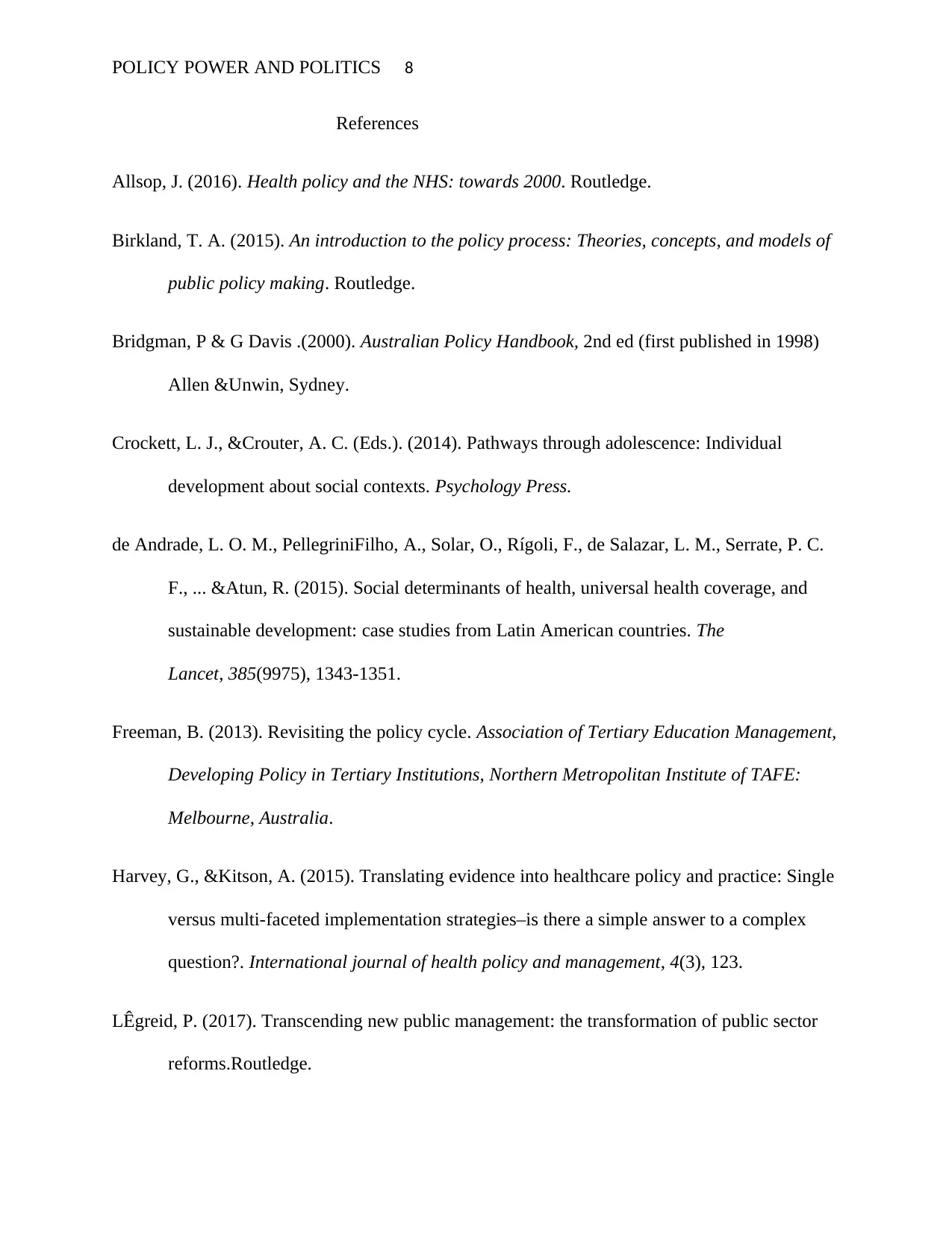
POLICY POWER AND POLITICS 8
References
Allsop, J. (2016). Health policy and the NHS: towards 2000. Routledge.
Birkland, T. A. (2015). An introduction to the policy process: Theories, concepts, and models of
public policy making. Routledge.
Bridgman, P & G Davis .(2000). Australian Policy Handbook, 2nd ed (first published in 1998)
Allen &Unwin, Sydney.
Crockett, L. J., &Crouter, A. C. (Eds.). (2014). Pathways through adolescence: Individual
development about social contexts. Psychology Press.
de Andrade, L. O. M., PellegriniFilho, A., Solar, O., Rígoli, F., de Salazar, L. M., Serrate, P. C.
F., ... &Atun, R. (2015). Social determinants of health, universal health coverage, and
sustainable development: case studies from Latin American countries. The
Lancet, 385(9975), 1343-1351.
Freeman, B. (2013). Revisiting the policy cycle. Association of Tertiary Education Management,
Developing Policy in Tertiary Institutions, Northern Metropolitan Institute of TAFE:
Melbourne, Australia.
Harvey, G., &Kitson, A. (2015). Translating evidence into healthcare policy and practice: Single
versus multi-faceted implementation strategies–is there a simple answer to a complex
question?. International journal of health policy and management, 4(3), 123.
LÊgreid, P. (2017). Transcending new public management: the transformation of public sector
reforms.Routledge.
References
Allsop, J. (2016). Health policy and the NHS: towards 2000. Routledge.
Birkland, T. A. (2015). An introduction to the policy process: Theories, concepts, and models of
public policy making. Routledge.
Bridgman, P & G Davis .(2000). Australian Policy Handbook, 2nd ed (first published in 1998)
Allen &Unwin, Sydney.
Crockett, L. J., &Crouter, A. C. (Eds.). (2014). Pathways through adolescence: Individual
development about social contexts. Psychology Press.
de Andrade, L. O. M., PellegriniFilho, A., Solar, O., Rígoli, F., de Salazar, L. M., Serrate, P. C.
F., ... &Atun, R. (2015). Social determinants of health, universal health coverage, and
sustainable development: case studies from Latin American countries. The
Lancet, 385(9975), 1343-1351.
Freeman, B. (2013). Revisiting the policy cycle. Association of Tertiary Education Management,
Developing Policy in Tertiary Institutions, Northern Metropolitan Institute of TAFE:
Melbourne, Australia.
Harvey, G., &Kitson, A. (2015). Translating evidence into healthcare policy and practice: Single
versus multi-faceted implementation strategies–is there a simple answer to a complex
question?. International journal of health policy and management, 4(3), 123.
LÊgreid, P. (2017). Transcending new public management: the transformation of public sector
reforms.Routledge.

POLICY POWER AND POLITICS 9
Lopes, E., Street, J., Carter, D., & Merlin, T. (2016).Involving patients in health technology
funding decisions: stakeholder perspectives on processes used in Australia. Health
Expectations, 19(2), 331-344.
Meier, K. J. (2016). The Politics of Sin: Drugs, Alcohol and Public Policy: Drugs, Alcohol and
Public Policy. Routledge.
Stanhope, M., & Lancaster, J. (2015). Public Health Nursing-E-Book: Population-Centered
Health Care in the Community. Elsevier Health Sciences.
Weiss, G. L., &Lonnquist, L. E. (2017). The sociology of health, healing, and illness.Routledge.
Lopes, E., Street, J., Carter, D., & Merlin, T. (2016).Involving patients in health technology
funding decisions: stakeholder perspectives on processes used in Australia. Health
Expectations, 19(2), 331-344.
Meier, K. J. (2016). The Politics of Sin: Drugs, Alcohol and Public Policy: Drugs, Alcohol and
Public Policy. Routledge.
Stanhope, M., & Lancaster, J. (2015). Public Health Nursing-E-Book: Population-Centered
Health Care in the Community. Elsevier Health Sciences.
Weiss, G. L., &Lonnquist, L. E. (2017). The sociology of health, healing, and illness.Routledge.
⊘ This is a preview!⊘
Do you want full access?
Subscribe today to unlock all pages.

Trusted by 1+ million students worldwide
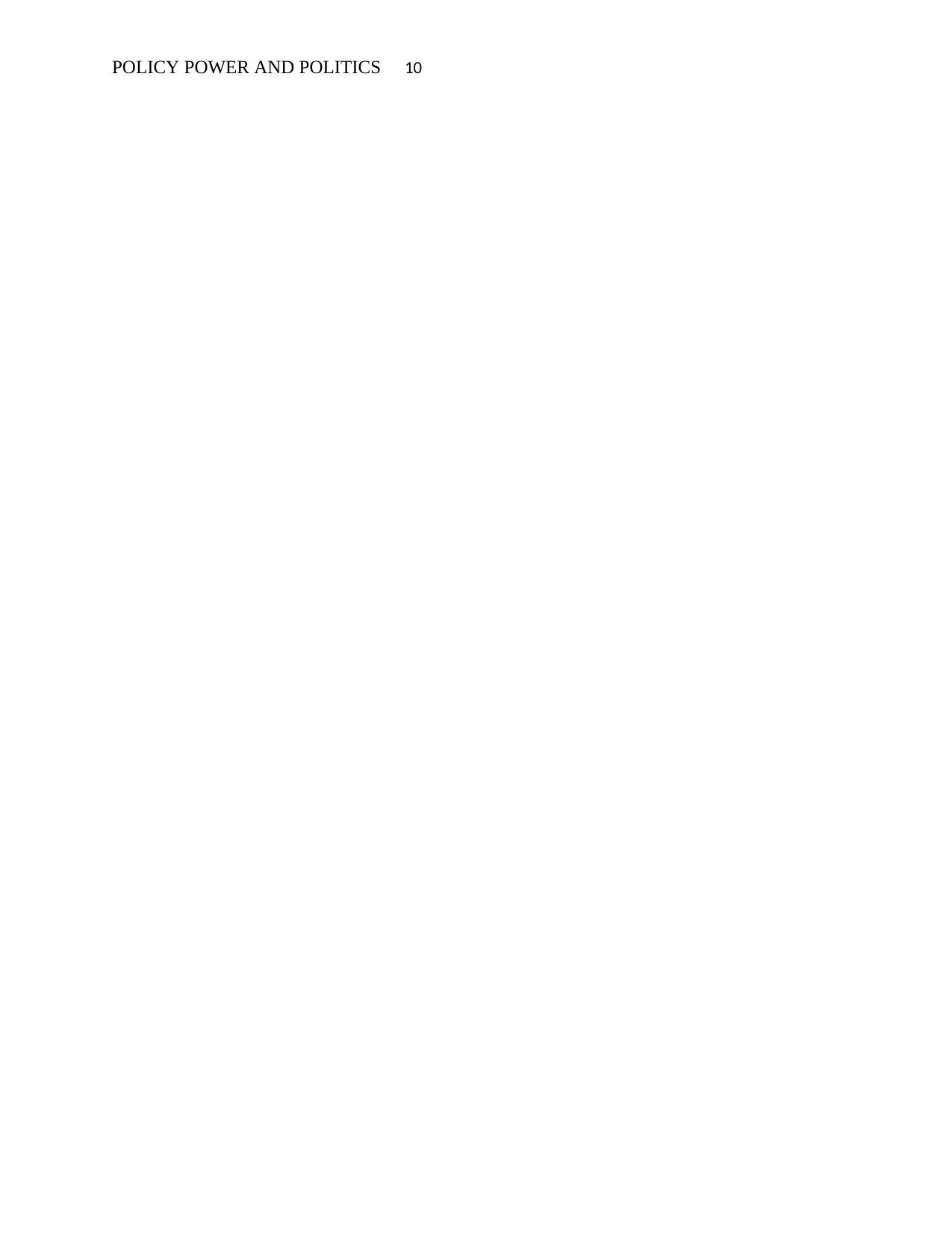
POLICY POWER AND POLITICS 10
1 out of 10
Related Documents
Your All-in-One AI-Powered Toolkit for Academic Success.
+13062052269
info@desklib.com
Available 24*7 on WhatsApp / Email
![[object Object]](/_next/static/media/star-bottom.7253800d.svg)
Unlock your academic potential
Copyright © 2020–2026 A2Z Services. All Rights Reserved. Developed and managed by ZUCOL.





